10 Best Places in Indiana for a Couple To Live on Only Social Security

Indiana can’t match Florida’s year-round warm weather, South Carolina’s beaches or Arizona’s desert vistas. In terms of affordability, however, the Hoosier State makes a strong case as a retirement destination.
Check Out: 7 Bills You Never Have To Pay When You Retire
Read Next: 3 Ways To Recession-Proof Your Retirement
In a study last year by the Missouri Economic Research and Information Center, Indiana had the eighth-lowest cost of living in the United States. A GOBankingRates study released just this month points out numerous Indiana cities well within financial reach for most retiring couples, even if they plan to get by on Social Security alone.
Those couples are pulling in combined benefits just under $3,600 a month these days, according to the Social Security Administration. The GBR study has determined the top 10 Indiana cities with an average overall cost of living within that framework, and also offering solid livability ratings. Our full methodology can be found at the end of this story.
There are other reasons to consider retiring in Indiana, especially if you like four-season living and can handle some hot summers and cold winters. Social Security benefits aren’t taxed in Indiana, though pensions and retirement savings are. The Hoosier State also offers Midwest friendliness and plenty of farm charm.
Read on for our 10 best Indiana retirement cities for Social Security-only couples, in reverse order.
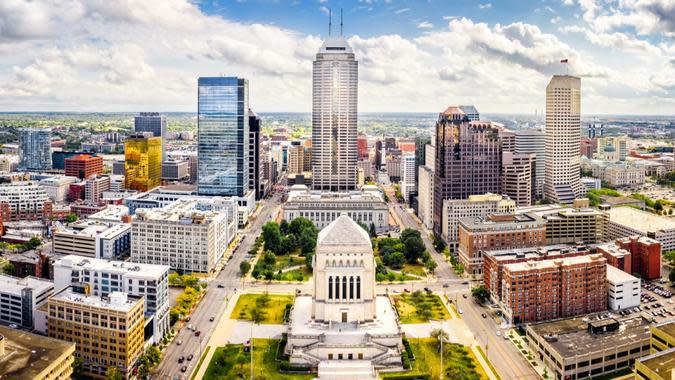
10. Indianapolis
Average rent: $1,330
Average total monthly cost of living: $2,653.00
Livability score: 77
Retired couples on a tight budget still wanting to live in a large city may want to give Indianapolis a look. With average monthly rents in the $1,300 range and total average monthly living costs less than $2,700, Indianapolis is less expensive than many other state capitals.
Groceries will cost a retired couple about 6.5 percent less than the national average, and utilities come in about 10 percent lower. With a population of about 880,000, Indianapolis offers big league sports and many of the cultural and entertainment opportunities you would expect from a big city.
See: 10 Things Boomers Should Consider Selling in Retirement
Suze Orman: 5 Social Security Facts Every Soon-To-Be Retiree Must Know
Sponsored: Get Paid To Scroll. Start Now

9. Kokomo
Average rent: $840
Average total monthly cost of living: $2,144.77
Livability score: 66
Kokomo’s livability score from AreaVibes (66) may not blow you away, but it’s really inexpensive to live here. Average monthly rents come in well below $1,000 in an era when sub-$1,000 rents are becoming rare in the U.S. Kokomo is located in north-centra Indiana, about an hour north of Indianapolis. Its population increased by more than 30% between 2010 and 2020 and now stands at about 60,000.
Retirement Savings: How Much Money You Need for Every Year Past Age 65
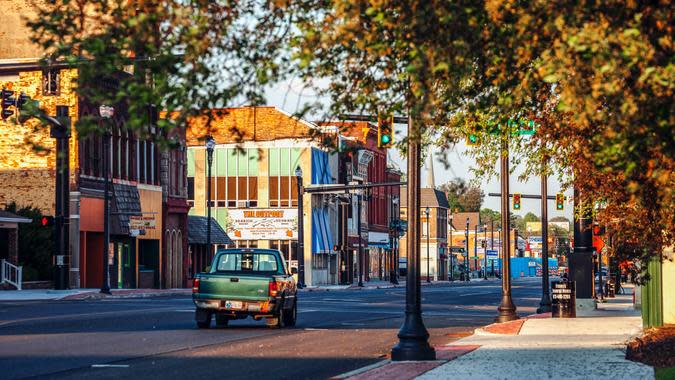
8. Terre Haute
Average rent: $922
Average total monthly cost of living: $2,258.69
Livability score: 70
Another city with average monthly rents below $1,000, Terre Haute is located in western Indiana near the Illinois border. It is home to about 60,000 residents, Indiana State University and multiple museums and parks. Groceries in Terre Haute will cost a retired couple just $365 a month on average, well below national figures.
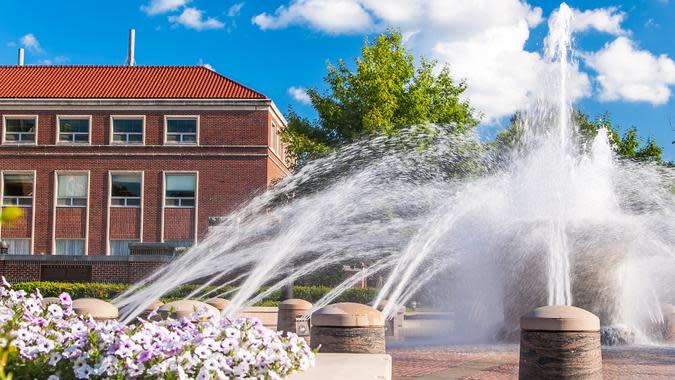
7. West Lafayette
Average rent: $1,799
Average total monthly cost of living: $3,128.81
Livability score: 89
If you’re looking to retire in a college town on a tight budget, West Lafayette may be worth considering. Home to Purdue University, West Lafayette has our list’s highest livability score and offers living costs within the budget of many Social Security-only couples. You’ll find it across the Wabash River from Lafayette, about 65 miles northwest of Indianapolis and 125 miles southeast of Chicago.
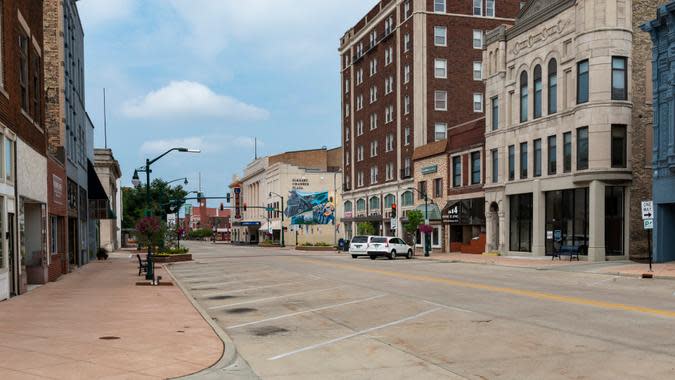
6. Elkhart
Average rent: $969
Average total monthly cost of living: $2,249.90
Livability score: 70
You’ll find Elkhart in northern Indiana, about five miles south of the Illinois border and 15 miles east of South Bend. Elkhart has about 54,000 residents and offers outdoor recreation, the Wellfield Botanical Gardens and multiple museums, including the Midwest Museum of American Art. Like many of the entries on our list, Elkhart is significantly less expensive than many other U.S. cities. Expenses below national averages include groceries (-8%), healthcare (-6.5%) and utilities (-7%).
Also: 10 Places To Retire That Are Just Like Arizona but Way Cheaper
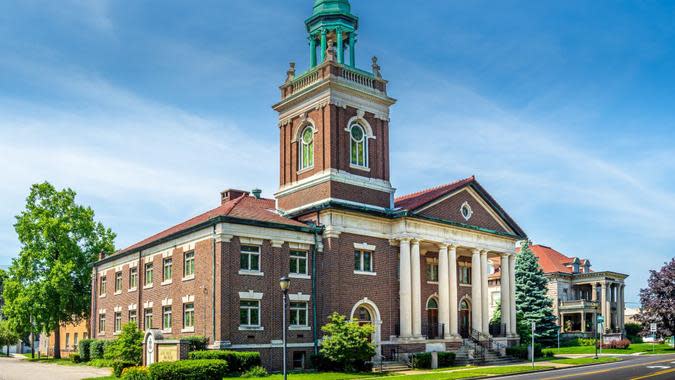
5. Mishawaka
Average rent: $1,189
Average total monthly cost of living: $2,465.68
Livability score: 75
Mishawaka is located about 10 miles west of Elkhart, near South Bend and the University of Notre Dame. It features more than two dozen parks, a riverwalk and numerous sites listed in the National Register of Historic Places. A retired couple will pay about $366 a month for groceries in Mishawaka, about $33 below the national average.

4. Jeffersonville
Average rent: $1,434
Average total monthly cost of living: $2,717.34
Livability score: 81
Often referred to as simply “Jeff,” this southern Indiana city of about 50,000 is located across the Ohio River from Louisville, Kentucky. Residents enjoy the NoCo Arts and Cultural District, the floating RiverStage event venue and multiple parks. Retired couples may appreciate Jeff’s average monthly healthcare costs, the lowest in our top 10 at $567.
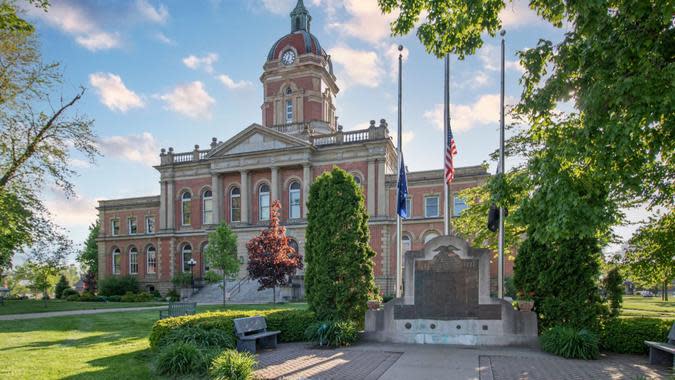
3. Goshen
Average rent: $1,115
Average total monthly cost of living: $2,404.58
Livability score: 81
Goshen is another northern Indiana city in the South Bend-Mishawaka-Elkhart area, with about 35,000 residents. It’s known for cranking out auto parts and recreational vehicles. Locals and visitors enjoy a weekly farmers’ market and walking/biking along the Pumpkin Vine Nature Trail or the Maple City Greenway, Groceries for a retired couple cost about $375 a month here.
Retirement Planning: How Much the Average Person 65 and Older Spends Monthly

2. Fort Wayne
Average rent: $1,134
Average total monthly cost of living: $2,427.49
Livability score: 83
Fort Wayne is a large city (population 265,000 and 425,000 in the metro area) located in northeast Indiana. It has received an All-American City Award four times, most recently in 2021. Attractions include the Foellinger-Freimann Botanical Conservatory, the Fort Wayne Museum of Art, the Fort Wayne Children’s Zoo and the History Center at Old City Hall.
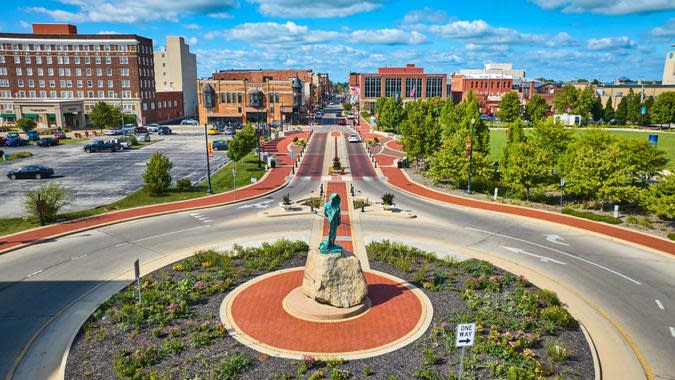
1. Muncie
Average rent: $896
Average total monthly cost of living: $2,164.45
Livability score: 81
If you’re a couple trying to get by on $3,593 a month, an average rent below $900 probably looks pretty good. Muncie has it, along with an average total cost of living that’s $1,200 below the national average and a respectable livability score of 81. Located about 60 miles northeast of Indianapolis, Muncie is home to about 65,000 residents, Ball State University, the David Owsley Museum of Art, the Minnetrista Museum and Gardens and the 60-mile Cardinal Greenway.
Methodology: GOBankingRates determined the best cities in Indiana for a couple to live on only Social Security checks based on the average monthly benefit for retired workers, $1,796.31 ($3,592.62 for a couple), sourced from the Social Security Administration. GOBankingRates first isolated all cities in Indiana with a 2023 average monthly rent under $2,200 and a size rank below 2,000th. GOBankingRates then used Sperling’s Best Places to find the cost-of-living index for each listed city, looking at grocery and healthcare index scores. Next, GOBankingRates used data from the Bureau of Labor Statistics 2022 Consumer Expenditure Survey to find the annual expenditure amount for groceries (“food at home”), utilities and healthcare costs for people aged 65 and older in order to find how much a couple 65 and over would spend on groceries, utilities and healthcare in each city on a monthly basis. GOBankingRates then added monthly housing, grocery, utilities and healthcare costs together to find where a couple 65 and older could survive on their Social Security or less. To qualify for the study, cities had to have a livability score above 65 as sourced from AreaVibes. GOBankingRates scored and combined both livability and monthly necessities expenditures, with the lowest score being best, to determine final rankings. All data was collected and is up to date as of December 6, 2023.
More From GOBankingRates
I'm a Financial Expert: Here's How You Can Save $10K or More in the Next Year
4 Reasons You Should Be Getting Your Paycheck Early, According to An Expert
10 Ways to Turn Your Six-Figure Salary Into Generational Wealth
This article originally appeared on GOBankingRates.com: 10 Best Places in Indiana for a Couple To Live on Only Social Security